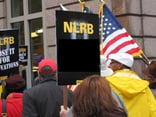When someone receives occupational direction and/or compensation from more than one entity, who’s the boss? Sometimes it’s obviously one or the other, sometimes it’s not clear which one is, and sometimes the answer may be “both.” These unclear situations are fairly common; consider franchise operations where the franchisor exerts some controls over how the franchisee does business, workplaces where “temp agencies” supply workers who receive at least some directions from the host but get paid by the agency, and worksites where a prime contractor integrates services by subcontractors and their employees. Identifying the boss(es) has important implications, not just for who writes a paycheck but for who is subject to legal responsibilities and prohibitions.
Read MoreAudit, Compliance and Risk Blog
Tags: Business & Legal, Employer Best Practices, Employee Rights, NLRB
When someone receives occupational direction and/or compensation from more than one entity, who’s the boss? Sometimes it’s obviously one or the other, sometimes it’s not clear which one is, and sometimes the answer may be “both.” The answer has important implications, not just for who writes a paycheck but for who is subject to legal requirements and prohibitions under applicable laws.
Read MoreTags: Business & Legal, Employer Best Practices, Employee Rights, NLRB, directors & officers
NLRB Sends Mixed Signals for Future of Employee Electronic Communications
Posted by Linda Riedemann Norbut on Tue, Mar 20, 2018
On December 19, 2017, the National Labor Relations Board (NLRB) asked the U.S. court of Appeals for the Ninth Circuit to affirm the NLRB’s ruling in Purple Communications, Inc., a 2014 NLRB decision which ruled that employers must presumptively permit “employee use of email for statutorily protected communications on nonworking time.” The ruling applies to those employers who have chosen to give employees access to their email systems, and the presumption of employee rights can be overcome in only very limited circumstances.
Read MoreTags: Employer Best Practices, Employee Rights, Internet, NLRB
 Most employers promulgate a wide range of employee-related policies and work rules, which some compile in employment manuals. All too frequently, these policies and work rules contain ambiguities that employees try to parse to understand what rules really apply, and why. What if employees interpret – or might reasonably interpret – an ambiguity in a way that appears to restrict employees’ rights to organize themselves? Do these provisions violate the National Labor Relations Act (NLRA)?
Most employers promulgate a wide range of employee-related policies and work rules, which some compile in employment manuals. All too frequently, these policies and work rules contain ambiguities that employees try to parse to understand what rules really apply, and why. What if employees interpret – or might reasonably interpret – an ambiguity in a way that appears to restrict employees’ rights to organize themselves? Do these provisions violate the National Labor Relations Act (NLRA)?
Tags: Business & Legal, Employer Best Practices, Employee Rights, NLRB, directors, directors & officers
If someone receives occupational direction and/or compensation from more than one entity, then who’s the boss? Sometimes it’s obviously one or the other, sometimes it’s not clear which one is, and sometimes the answer may be “both.” The answer has important implications, not just for who writes a paycheck but for who is subject to legal requirements and prohibitions under federal, state and local laws. The National Labor Relations Board (NLRB) upended established definitions in 2015, in a decision that Browning-Ferris Industries of California (BFI) was a joint employer with the company (Leadpoint Business Services) that provided employees who worked at one of BFI’s sanitary landfills, since BFI reserved the right to intervene in a variety of labor decisions. By a party-line 3:2 vote (with Democrats in the majority) NLRB “restated” agency and judicial precedent and found that the two companies were indeed joint employers, which realigned the employees’ access to collective bargaining (NLRB’s area of jurisdiction). The other two members dissented vociferously, for a variety of reasons.
After the BFI decision, employer groups and many Republican legislators argued that the correct standard was actual control not potential control, and that the majority was abandoning the common law approaches it claimed to follow. Early in December 2017, the U.S. House of Representatives passed legislation to write a definition of “joint employer” into the National Labor Relations Act (NLRA), in order to reverse this expansive interpretation (HR 3441, the “Save Local Business Act”). However, on December 14 the NLRB – now with a 3:2 Republican majority after President Trump filled two intervening vacancies – voted on a party line vote to rescind the BFI case analysis and return to an actual control test. The new decision is in Hy-Brand Industrial Contractors, Ltd. and Brandt Construction Co., as a single employer and/or joint employers. The remainder of this note discusses the issue and this decision, which probably resolves the issue … until the next election that changes the balance of power again.
Who Can Be a “Joint Employer” Under the NLRA?
The NLRA does not presently include a statutory definition of “joint employer” (or even “employer”, for that matter, other than to clarify that “any person acting as an agent of an employer” is also considered an employer (29 USC § 152(2))). In the absence of a statutory definition, NLRB and courts look to other labor laws and the “common law” when considering whether an employer-employee relationship exists. This case-specific review allows flexibility to adapt policies to changing workplace realities, but also means that guidance can be unclear and tends to vary with the opinions of a majority of the five NLRB Board members.
Read MoreTags: Business & Legal, Employer Best Practices, Employee Rights, NLRB
Federal laws prohibit employers from basing employment decisions on a variety of factors, including “sex.” This term is not defined, leaving its interpretation to change and expand with social changes and court decisions. The central entity creating and applying these interpretations is the Equal Employment Opportunity Commission (EEOC), which administers and enforces Title VII of the Civil Rights Act of 1964 and a variety of subsequent laws. On July 15, EEOC reaffirmed its present interpretation, in an enforcement decision in which the plaintiff claimed he was denied access to a promotion because he’s gay (Baldwin v. Foxx). The EEOC’s order includes a clear summary of the agency’s approach to sex discrimination cases:
Tags: Corporate Governance, Business & Legal, Employer Best Practices, Employee Rights, Workplace violence, EEOC, NLRB
Supreme Court Expands Employers’ Duty To Avoid Religious Discrimination
Posted by Jon Elliott on Thu, Jul 09, 2015
Federal laws protect individuals against job discrimination based on a variety of “protected classes” of characteristics. Most represent physical characteristics, such as race, sex, and disability. In addition, however, Title VII of the Civil Rights Act of 1964 prohibits a prospective employer from refusing to hire an applicant in order to avoid accommodating a religious practice that it could accommodate without undue hardship.
Tags: Corporate Governance, Business & Legal, Employer Best Practices, Employee Rights, EEOC, NLRB
Department of Labor Proposes More Anti-Discrimination Rules For Federal Contractors
Posted by Jon Elliott on Thu, Feb 12, 2015
On January 30, the U.S. Department of Labor’s Office of Federal Contract Compliance Programs (OFCCP) published a proposal to revise its requirements for covered Federal Government contractors and subcontractors, including federally assisted construction contractors and subcontractors. This proposal would implement provisions in Executive Order (EO) Number 13672, which President Obama issued on July 21, 2014 (I blogged about the E.O. here). These revisions expand anti-discrimination responsibilities of federal contractors and federal grant recipients, to cover “sexual orientation” and “gender identity.” Once implemented, employment practices in these workplaces will match private employers’ responsibilities under a growing number of state laws, and under some federal court cases interpreting Title VII of the Civil Rights Act of 1964 (Title VII).
Tags: Corporate Governance, Business & Legal, Employer Best Practices, Employee Rights, EEOC, NLRB, Disability benefits
"Supervisors” Whose Discrimination Automatically Involves Employers
Posted by Jon Elliott on Wed, Jul 10, 2013
Title VII of the Civil Rights Act of 1964 provides a wide range of anti-discrimination measures, including prohibitions against employment discrimination based on race, color, religion, sex (or “gender”), and national origin. Title VII is administered by the Equal Employment Opportunity Commission (EEOC), and enforced when EEOC or aggrieved employees file lawsuits in federal court.
Tags: Corporate Governance, Business & Legal, Employer Best Practices, Employee Rights, Workplace violence, EEOC, NLRB
Employment Law: Age Discrimination Costs Employer $2 Million
Posted by Jon Elliott on Thu, Jun 13, 2013
Persons over 40 years old form a protected class under the Age Discrimination in Employment Act (ADEA) of 1967. Although separate from Title VII of the Civil Rights Act of 1964, ADEA provides protections similar to those preventing discrimination based on sex, race and religion. It applies to each employer “engaged in commerce who has twenty or more employees for each working day in each of twenty or more calendar weeks in the current or preceding calendar year.” It is administered by the Equal Employment Opportunity Commission (EEOC), which promulgates regulations and guidelines similar to those for Title VII and the Americans with Disabilities Act.
Tags: Corporate Governance, Business & Legal, Employer Best Practices, Employee Rights, EEOC, NLRB









